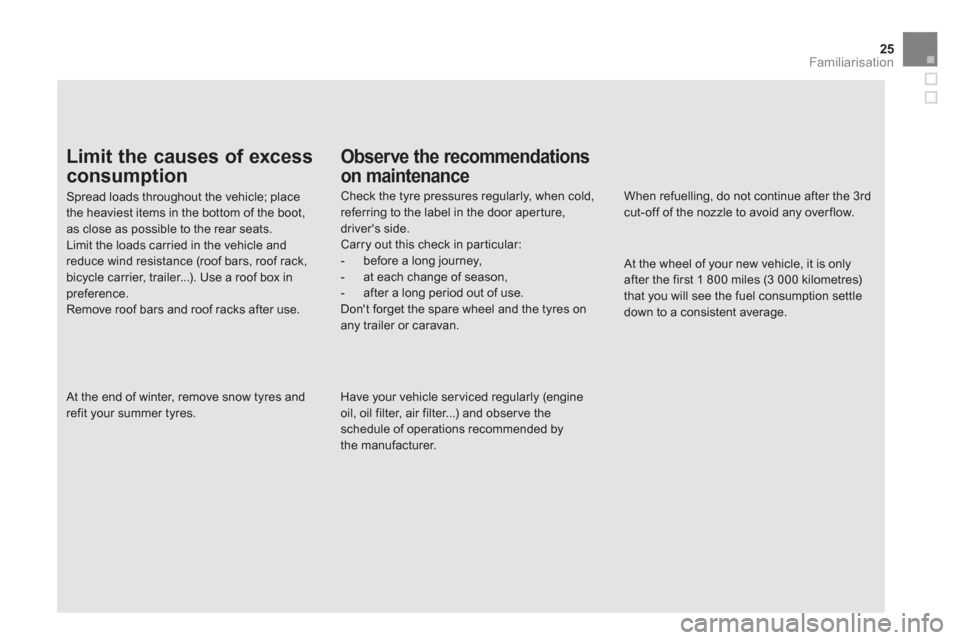Page 27 of 348

25
Familiarisation
Limit the causes of excess
consumption
Spread loads throughout the vehicle; place the heaviest items in the bottom of the boot,as close as possible to the rear seats.Limit the loads carried in the vehicle and reduce wind resistance (roof bars, roof rack, bicycle carrier, trailer...). Use a roof box inpreference.Remove roof bars and roof racks after use.
At the end of winter, remove snow tyres and refit your summer tyres.
Observe the recommendations
on maintenance
Check the tyre pressures regularly, when cold, referring to the label in the door aper ture, driver's side.Carry out this check in par ticular:- before a long journey,- at each change of season,- after a long period out of use. Don't forget the spare wheel and the tyres onany trailer or caravan.
Have your vehicle ser viced regularly (engine oil, oil filter, air filter...) and obser ve the schedule of operations recommended by the manufacturer.
When refuelling, do not continue after the 3rdcut-off of the nozzle to avoid any over flow.
At the wheel of your new vehicle, it is only after the first 1 800 miles (3 000 kilometres) that you will see the fuel consumption settledown to a consistent average.
Page 168 of 348

Ty r e u n d e r - i nfl ation detection System which automatically checks the pressure of the tyres while driving.
Sensors fitted in each valve trigger a warning in
the event of malfunction (speed above 12 mph(20 km/h)).
The spare wheel is not fitted with a sensor.
All repairs and changing of tyres on a wheel fitted with this system must becarried out by a CITROËN dealer or a
qualified workshop.
If, when changing a tyre, you install a wheel which is not detected by your vehicle (example: fitting of snow tyres),you must have the system reinitialised by a CITROËN dealer or a qualifiedworkshop.
This message is also displayed whenone of the wheels is away from thevehicle (being repaired) or when one or more wheels without a sensor are fitted.
The tyre under-inflation detectionsystem is an aid to driving which doesnot replace the need for the driver to bevigilant or to drive responsibly.
This system does not avoid the needto have the tyre pressures checkedregularly (refer to "Identification markings") to ensure that the optimumdynamic per formance of the vehicle is maintained and prevent premature wear of the tyres, particularly in arduousdriving conditions (heavy load, highspeed). The tyre pressures must be checked cold, at least once a month. Remember to check the pressure of the spare wheel.
The tyre under-inflation detectionsystem may experience temporary inter ference due to electromagnetic signals on a frequency close to thatused by the system.
A message appears in the instrument panel screen, accompanied by an audible signal, to
identify the wheel concerned.
Under-infl ated tyre
This warning lamp andthe STOPwarning lamp come on, accompanied by an audible signal and a message in the
instrument panel screen identifying the wheelconcerned. �)Stop immediately, avoiding any sudden
movement of the steering wheel and the brakes. �) Change the damaged wheel (punctured or
very deflated tyre), and have the tyre pressurechecked as soon as possible.
Puncture
A message appears in the instrument panel
screen, accompanied by an audible signal,
to identi
fy the wheel or wheels which are not
detected or to indicate a fault in the system.
Contact a CITROËN dealer or a qualified
workshop to replace the faulty sensor(s).
Sensor(s) not detected or faulty
�)Check the tyre pressures as soon as possible. This check must be carried out when the tyres are cold.
Page 188 of 348

Changing a wheel Procedure for changing a faulty wheel for the spare wheel using the tools provided with the vehicle.
Th
e tools are installed in the boot under
the floor.
Access to the tools
List of tools
All of these tools are specific to your vehicle and can vary
according to the level of equipment. Do not use them for
other purposes.
1. Wheelbrace.
For removing the wheel trim and removing the wheel bolts. 2.Jack with integral handle.
For raising the vehicle. 3."Bolt cover" tool.
For removing the bolt protectors (covers) on alloy wheels. 4. Wheel trim remover.
For removing the alloy wheel finishers. 5. Socket for the security bolts (located in the glove
box).
For adapting the wheelbrace to the special "security"bolts. 6.Wheel chocks for blocking the vehicle's wheels.7. Towing eye.
See "Towing the vehicle". 8.Extension spanner.
For slackening/tightening the spare wheel carrier nut. 9. Emergency release control for the electric parking brake.
See the "Electric parking brake" section, "Emergencybraking".
Tyre under-infl ation detection
The spare wheel is not fitted with a sensor. The punctured wheel must berepaired by a CITROËN dealer or a
qualified workshop.
Page 241 of 348

239Technical data
Identifi cation markings
Various visible markings for the identification of your vehicle.
A.Vehicle Identification Number (VIN) under the bonnet. This number is engraved on the bodyworknear the damper support.
The tyre pressures must be checked when the tyres are cold, at least oncea month.
If the tyre pressures are too low, this increases fuel consumption. B.Vehicle identification Number (VIN) on
the windscreen lower crossmember. This number is indicated on a self-adhesive
label which is visible through the windscreen.
C.Manufacturer's label.The VIN is indicated on a self-destroyinglabel affixed to the door aper ture, on the
passenger's side.
D.Tyre/paint label.This label is affixed to the door pillar, on thedriver's side. It bears the followin
g information:
- the tyre inflation pressures with and
without load,
- the wheel rim and tyre sizes,
- the brands of tyre recommended by themanufacturer,
- the inflation pressure of the spare wheel,
- the paint colour code.